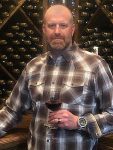
For the past two decades Brannon Boegner, our winemaker and vineyard manager, has dedicated himself to growing and producing premium vinifera still and sparkling wines along the 1800 foot elevations of the Dahlonega Plateau. Establishing Wolf Mountain Vineyards and Winery in 1999 with his father Karl, the two worked with consultants from both the California and Virginia wine industries to develop the Estate Vineyards along with their winemaking techniques and philosophies. After working together for many years, Brannon took over as head winemaker in 2010. Since that time he has been awarded hundreds of medals at the most prestigious wine competitions in California. He also became the first winemaker on the East Coast to be awarded Best of Class and Double Gold Medals at the San Francisco Chronicle, San Francisco International and Los Angeles International Wine Competitions in Premium Sparkling, White and Red Wine Categories.

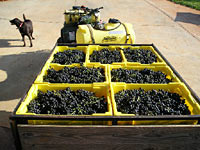
The Old World ambiance of our Cellar and Cask Room sets the stage for our labor intensive protocols which focus on a less invasive use of gravity, minimizing the need for filtration and aggressive processing that sacrifice quality. Our Award Winning wines are hand crafted with emphasis focused on making the highest quality wines possible.
All of Wolf Mountain’s Estate Vineyards are harvested by hand and then sorted into small lugs. The lugs are then brought to the winery crush pad for processing. Our state of the art Europress by Scharfenberger is one of the highest quality presses available. The press features multiple computerized pressing cycles specifically designed for different styles of wine such as a very long and delicate press cycle for sparkling wines that avoids crushing grape seeds which impart a distinct bitterness to the final wine.


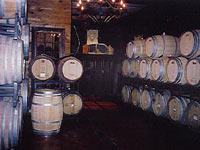
All of our white wine production is hand sorted to remove leaves, raisins, and damaged grapes. After sorting the grapes are whole cluster pressed instead of crushed and destemmed, this causes less damage to the fruit and preserves the delicate flavors and aromas that the local Georgia fruit offers. Once pressed, the juice is gravity fed into one of the fermentation tanks located 14 feet below in the cellar. These steps ensure only the highest quality juice is used to produce our award winning wines.
Red wines are hand sorted as well, gently destemmed and gravity fed from the sorting table to one of the red wine, open top fermenters located in the cellar below. When the tank is full, the must (mix of grapes and juice) is chilled to the appropriate temperature and prepared for fermentation. Once fermentation begins and the skins separate from the juice, we begin the Old World technique of punching the resulting caps down by hand with a stainless steel mallet.
We ferment approximately 3 tons of red wine fruit in each of our 800 gallon stainless steel tanks. The tanks ratio of height to width is specifically designed to allow us to punch the caps of the fermenting red grapes by hand, gently mixing the skins with the fermenting wine. This is done four times a day with additional pump-overs twice daily. These techniques allow us to extract exceptional color and flavors from the fruit. Once fermentation is over, the wine is racked off (transferred) to a settling tank and the remaining skins are gently pressed. The wine settles for a few days in a tank and then it is barreled down for aging in our cask room.
The wines at Wolf Mountain are more European in style than Californian. As a result, we use French, Hungarian and American Oak Barrels for the aging of all our wines. The emphasis is on the rich fruit flavors our terroir offers and not on excessive oak flavor. Our philosophy is to blend our grape varieties to achieve more complexity, as is done throughout Europe, where the climate is similar to the North Georgia Mountains.
Sparkling Wines
Wolf Mountain Vineyards produces four types of sparkling wines using the French-style Méthode Champenoise. This multistep process, developed in France’s Champagne region, puts the still wine through a second fermentation in the bottle.
Méthode Champenoise Defined
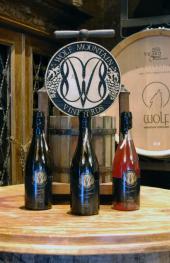
Wolf Mountain Vineyards produces three types of sparkling wines using French-style Méthode Champenoise.
While many wineries inject still wines with carbon dioxide (CO2) gas to render them effervescent, Wolf Mountain Vineyards produces sparkling wines using the French-style Méthode Champenoise. This multistep process, developed in France’s Champagne region, puts the still wine through a second fermentation in the bottle.
Méthode Champenoise is the traditional French method for producing sparkling wine. Originally developed by Dom Pérignon and his fellow monks, and refined over the centuries by the many important sparkling wine producers that followed. One of three ways of making sparkling wine, it is by far the most complicated and labor intensive.
It starts with making a base wine from grapes that are picked about a month earlier than table wine grapes. This produces a high acid, low alcohol wine. Once the wine has been clarified and is ready to be bottled, yeast and cane sugar is added to the wine and mixed thoroughly. The wine is bottled and finished with a crown cap producing a seal strong enough to withstand the high pressures generated.
While in the bottle, the yeast consumes the sugar and produces more alcohol and carbon dioxide. However, being a sealed bottle, the CO2 has nowhere to go and dissolves into the wine. After about 60 days the alcohol has reached 12% and the pressure has reached 120 psi. The bottles are then stored on their side for 6 – 18 months. This time is called tirage and the longer a wine is en tirage the more complex and bready the wine will be.
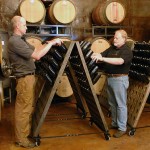 Finally we have to finish the sparkling wine. However, we must remove the yeast first through a process called riddling. We invert the bottle on a riddling rack and twist each bottle ¼ of a turn every day for one to two months. This works the yeast into the neck and we can then remove the bottle and put it into a bath of food grade glycol that is chilled to -2°f. The necks freeze and capture the yeast allowing the bottle to be turned upright with out the yeast clouding the wine again. The bottle is then disgorged, meaning the cap is removed quickly and the pressure in the bottle shoots the plug of ice and yeast out at high velocity. If done correctly the sparkling wine stays in the bottle.
Finally we have to finish the sparkling wine. However, we must remove the yeast first through a process called riddling. We invert the bottle on a riddling rack and twist each bottle ¼ of a turn every day for one to two months. This works the yeast into the neck and we can then remove the bottle and put it into a bath of food grade glycol that is chilled to -2°f. The necks freeze and capture the yeast allowing the bottle to be turned upright with out the yeast clouding the wine again. The bottle is then disgorged, meaning the cap is removed quickly and the pressure in the bottle shoots the plug of ice and yeast out at high velocity. If done correctly the sparkling wine stays in the bottle.
We finish the process by replacing the lost wine with dosage made up of sugar syrup and wine. The recipe for the dosage determines the style of sparkling wine being produced. After a week in the bottle, it’s ready to be chilled and served.
